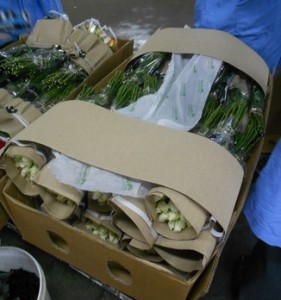Best Practices: Flower Transport and Storage
Floralife Research Updates are a valuable source of flower knowledge aimed at helping growers, transporters, wholesalers and retailers get the most from their investment, and present healthy, long-lasting flowers to the consumer. Let’s take a look at a recent flower transport and storage essay, “Best Practices for Shipping & Storage of Fresh Cut Flowers.”
It’s a wonder that cut flowers last 7 days or longer in the home when you consider:
…flowers are being shipped further than ever before to reach the consumer markets. Flowers sold in retail outlets today are often 10 days old or older. At the extreme, flowers may be stored prior to processing by bouquet manufacturers, wholesalers and retailers for 14 – 21 days or in ocean liner shipping containers for 10 – 21 days.
This Research Update, authored by Terril Nell, Ph.D., (AAF Professor Emeritus University of Florida’s Environmental Horticulture Department) offers some valuable flower transport and storage tips on handling hydration, loss of stored carbohydrates, hormonal changes in flowers, and disease. Here are some highlights!
Hydration Challenges during Flower Transport and Storage
Remember, leaves and flowers are 70 – 95% water, and hydration is key. It takes water for the petals to expand and flowers to open. Humidity is important, too. A humidity count of 80-85% will help extend the life of the flower up to 6 to 8 days. BUT… at 93%, Botrytis becomes an issue. More on that in a bit.
Loss of Stored Carbohydrates during Flower Transport and Storage
Carbohydrates and sugars provide energy for cell expansion and for the normal functioning of cells. Flowers store the sugars produced during growth, and they continue to consume them throughout storage and shipping. Flower foods replenish the carbohydrates, and cold storage temperature slows down the consumption rate.
Hormonal Changes during Flower Transport and Storage
Ethylene and other bad actors cause leaf yellowing, bud and flower drop, short vase life and failure of flowers to open. Ethylene can invade from nearby decaying fruit, from the flower itself, or from injury to the flower caused by, for example, vibration during transport. Ethylene inhibitors such as Floralife EthylBloc™ can protect the flower from damage.
Disease during Flower Transport and Storage
“Botrytis occurring during storage and shipping may be the biggest challenge for the industry.” Water on leaves and flowers at time of boxing, humidity of 93% or greater in the box, and mechanical injury to leaves and petals…these are all big Botrytis contributors. And once you’ve got it, you’ve got it. So prevention is key. Cooling the flowers and allowing the surface water to dry from the stems will help, as will Floralife TransportCARE® sheets.
The Research Update closes with a really useful bullet list of best practices called “Steps for Successful Shipping and Storage” that you’ll want to print out and hang on your wall. So be sure to read the whole thing. As we said, these were just the highlights. So, what are your biggest challenges in flower transport and storage? Let us know in the comments section!

